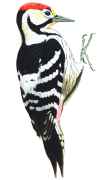|
Home
| Birds | Bohemia | Moravia
| Tours | Guiding | Literature
| Links |
MORAVIA
|
Join
us in Moravia in spring 2005 to see some of this fantastic region's great
birds: click here
|
| If
visiting South Moravia (the warmer wine growing region of the country in
the very south-east) then Vienna Airport in Austria is often a better option
than Prague as a point of arrival. Vienna is nearer to the best Moravian
sites by road and has more flights from, for example, UK airports (see
Where
To Watch Birds in Eastern Europe). |
It is feasible
to see all ten European woodpecker species in Moravia, though of course
not all in the same areas. Quality birding is available all year round
in Moravia as many key species are resident. A good place to start is the
Palava
Biosphere Reserve in South Moravia: a real gem. An internationally
important habitat here is floodplain forest (see photo above). There are
also broadleaved woodland, meadows, vineyards and limestone hills, all
in a quite compact area. White-tailed Eagle, Black & Red Kites and
Peregrine and
Saker Falcons breed. In most winters one or two Wallcreepers reside in
the area's stone quarries. The adjacent Nove Mlyny Reservoirs are
a series of three large waters along the River Dyje. The middle
reservoir, with its islets, banks and trees, is arguably of most birding
interest, and is part of the Palava reserve. Most of the wetland is frozen
in winter though there are usually several, sometimes up to 50, White-tailed
Eagles present amongst the lingering wildfowl. Breeding species include
Red-crested Pochard, White-tailed Eagle, a few pairs of Mediterranean,
Yellow-legged and Common Gulls and Peregrine Falcon. In autumn and winter
there are thousands of Tundra Bean and White-fronted Geese, Goosander,
Smew, Goldeneye and other ducks. Rarities found at Nove Mlyny include
Cattle Egret, Sabine’s Gull and every year a few Red-breasted Goose winter.
The
landscaped gardens and ponds at nearby
Lednice are easy to work
and good for woodpeckers, breeding and passage ducks and a noted rarity
site with species such as the Czech Republic's 5th Sociable Plover in September
and October 1986, the only Czech Baird’s Sandpiper on 2nd September 1981
and the first Pectoral Sandpiper in September 1973. The Bile Karpaty
(White Carpathians) bordering Slovakia rise to around 970 m. The mixed
forests here host breeding
Honey Buzzard, Hazel Grouse, White-backed Woodpecker and Barred Warbler
amongst others.
In
the very south-east corner of Moravia, nestling alongside the Austrian
border is Soutok (see photograph to right) a wonderful area of flooded
oak, ash, elm and poplar woodlands, ox-bows, pools, pastures and meadows
where the Morava and Dyje Rivers meet. Until 1990 this area was very much
out-of-bounds being right on the "Iron Curtain" as the concrete bunkers
which dot the area bear witness to. This closed-off status contributed
to Soutok becoming a haven for wildlife. Breeding birds include Black and
White Storks,
Red & Black Kites, Saker and Eastern Imperial Eagle, Middle Spotted,
Black and Grey-headed Woodpeckers, River and Barred Warblers, Collared
Flycatcher and Short-toed Treecreeper. On passage there are more storks
and kites, wildfowl and waders. |

|
 |
In
the north and east of Moravia montane areas like the Hostynske Hills,
the BeskydyMountains
and the Jeseniky Mountains (the highest range
in Moravia) are
blanketed in vast forests, with several areas of almost virgin habitat.
Though the steep slopes strewn with fallen, rotting timber often
make it hard work,
some areas of these uplands are home to raptors, grouse, warblers, flycatchers,
White-backed Woodpecker and large mammals such as Lynx and sometimes Wolf.
The varied wetland habitats in and around the Tovacovske Ponds
(near the village of the same name, south of Olomouc) have become somethong
of a passage and rarity hot-spot. Black-necked Grebe, Water Rail, Wryneck,
and Great Reed and Barred Warblers breed, whilst various divers, herons,
wildfowl, raptors, gulls, terns, waders and songbirds occur on spring and
autumn migration. |
For information
on birding in Moravia email us: info@czechbirding.com
©
czechbirding.com 2004
|
Home
| Birds | Bohemia | Moravia
| Tours | Guiding | Literature
| Links |

